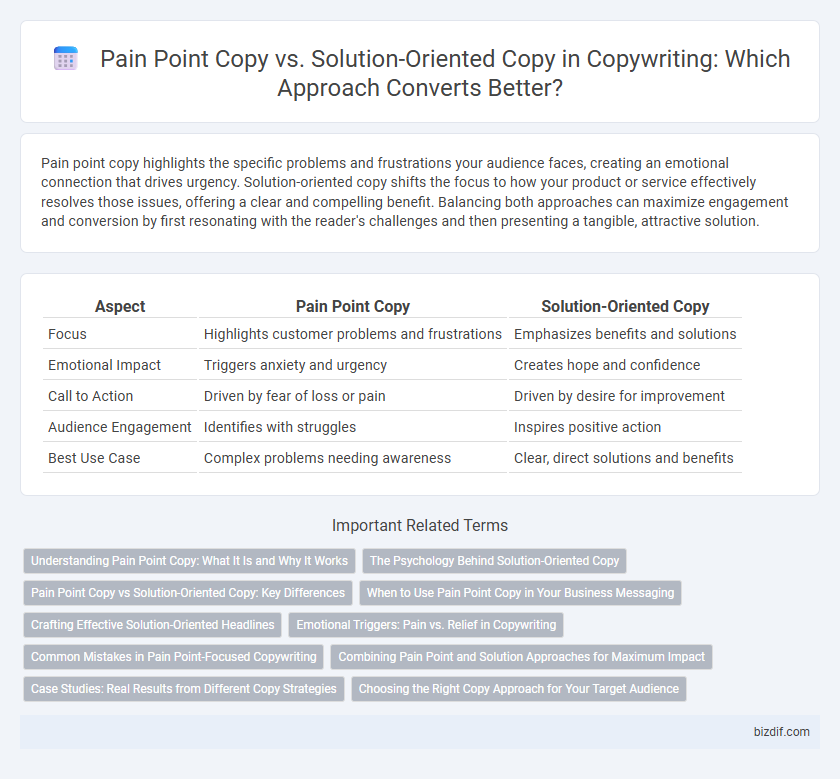Pain point copy highlights the specific problems and frustrations your audience faces, creating an emotional connection that drives urgency. Solution-oriented copy shifts the focus to how your product or service effectively resolves those issues, offering a clear and compelling benefit. Balancing both approaches can maximize engagement and conversion by first resonating with the reader's challenges and then presenting a tangible, attractive solution.
Table of Comparison
| Aspect | Pain Point Copy | Solution-Oriented Copy |
|---|---|---|
| Focus | Highlights customer problems and frustrations | Emphasizes benefits and solutions |
| Emotional Impact | Triggers anxiety and urgency | Creates hope and confidence |
| Call to Action | Driven by fear of loss or pain | Driven by desire for improvement |
| Audience Engagement | Identifies with struggles | Inspires positive action |
| Best Use Case | Complex problems needing awareness | Clear, direct solutions and benefits |
Understanding Pain Point Copy: What It Is and Why It Works
Pain Point Copy targets specific customer struggles by highlighting challenges that resonate deeply with their experiences, triggering emotional responses that drive engagement. This approach builds trust and empathy by acknowledging the audience's frustrations, making the message more relatable and compelling. By focusing on pain points, marketers create a strong connection that motivates potential buyers to seek out the advertised solution.
The Psychology Behind Solution-Oriented Copy
Solution-oriented copy leverages positive psychology by focusing on the desired outcome, tapping into the brain's reward system and motivating action through hope and empowerment. This approach stimulates the release of dopamine, encouraging readers to envision success and feel confident in the offered solution. By aligning messaging with human desire for progress and problem-solving, solution-oriented copy builds trust and drives higher conversion rates.
Pain Point Copy vs Solution-Oriented Copy: Key Differences
Pain Point Copy centers on identifying and emphasizing the audience's specific problems and frustrations, creating emotional resonance to highlight urgency. Solution-Oriented Copy shifts focus to presenting clear, actionable solutions and benefits that directly address those issues, driving motivation through positive outcomes. The key difference lies in Pain Point Copy's problem-first approach versus Solution-Oriented Copy's result-driven messaging, each serving unique roles in the customer decision journey.
When to Use Pain Point Copy in Your Business Messaging
Pain point copy is most effective when your audience is experiencing frustration, confusion, or dissatisfaction that your product can directly resolve, highlighting their struggles to create emotional resonance. Use pain point copy in early-stage marketing, such as awareness campaigns or landing pages, where identifying customer problems builds trust and motivates engagement. This strategy sharpens focus on specific challenges, making your offering the clear answer to urgent needs in competitive markets.
Crafting Effective Solution-Oriented Headlines
Effective solution-oriented headlines highlight specific benefits that address customers' core challenges, leveraging clear and action-driven language to capture attention. Incorporating targeted keywords related to the product or service enhances SEO performance while aligning with user intent. Prioritizing clarity and appeal ensures headlines resonate emotionally, increasing click-through rates and conversion potential in competitive markets.
Emotional Triggers: Pain vs. Relief in Copywriting
Pain point copy leverages emotional triggers by highlighting customers' frustrations, fears, and obstacles to create urgency and connection. Solution-oriented copy shifts focus to relief and positive outcomes, emphasizing hope, success, and transformation to motivate action. Balancing pain and relief in copywriting maximizes engagement by addressing emotions while guiding prospects toward desirable solutions.
Common Mistakes in Pain Point-Focused Copywriting
Common mistakes in pain point-focused copywriting include overemphasizing problems without offering clear solutions, which can leave potential customers feeling helpless rather than motivated. Writers often neglect to balance emotional triggers with actionable benefits, reducing engagement and conversion rates. Repetitive use of negative language may also alienate audiences instead of inspiring trust and interest in the product or service.
Combining Pain Point and Solution Approaches for Maximum Impact
Combining pain point and solution-oriented copy leverages the emotional impact of addressing customer struggles with the clarity of actionable benefits, creating a compelling narrative that drives engagement. By identifying specific challenges such as low conversion rates or customer dissatisfaction, and immediately presenting targeted solutions like optimized calls-to-action or personalized offers, marketers maximize persuasion and conversion. This integrated approach enhances message relevance and increases trust, ultimately boosting overall campaign effectiveness and ROI.
Case Studies: Real Results from Different Copy Strategies
Case studies reveal that pain point copy effectively captures audience attention by directly addressing customer frustrations, leading to higher engagement rates in e-commerce campaigns. In contrast, solution-oriented copy excels in B2B contexts by showcasing product benefits and clear value propositions, resulting in increased conversion rates and client retention. Data from these studies emphasize tailoring copy strategies based on target demographics and product type for optimal marketing performance.
Choosing the Right Copy Approach for Your Target Audience
Pain Point Copy targets the audience's specific challenges and frustrations, creating an emotional connection that drives urgency and engagement. Solution-Oriented Copy highlights the benefits and positive outcomes, appealing to customers seeking clear answers and value. Tailoring your copy approach depends on understanding your target audience's mindset--whether they respond better to empathy or to results-focused messaging.
Pain Point Copy vs Solution-Oriented Copy Infographic

 bizdif.com
bizdif.com